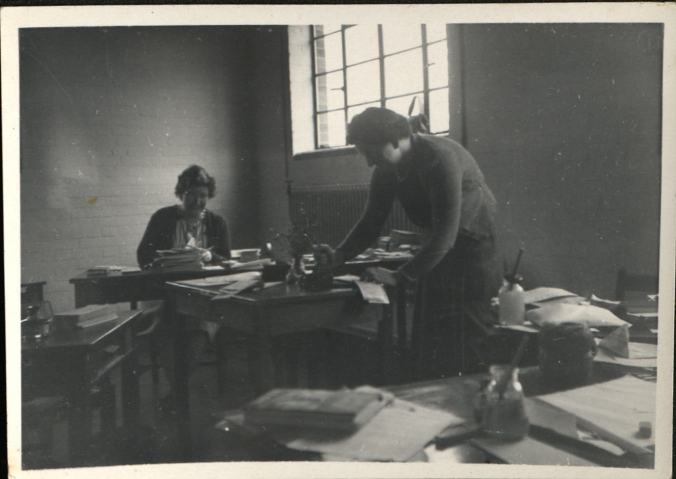Bletchley Park is best known as the secret home of British Code breakers during World War Two. We have no records from the site during this time…except for a small collection of photographs.
The photographs come from the papers of Dorothy Amelia Brown, who lived much of her life at Manor Road, Bletchley.
I want to focus on one particular image: D-X 1084/25/21. It depicts two women at work at Bletchley Park, some time after 1943. We believe that they are in either Block F or Block G. The bare white-washed brick wall, and large glass windows all reflect the utilitarian nature of the huts and blocks that were literally thrown-up in the grounds of the manor house, as the importance of the Code breakers’ secretive work was recognised within the military, and the workforce swelled.
 During World War Two Block F housed the specialist code breaking sections run by Max Newman and Ralph Tester, which both pioneered some of the technological developments that enabled complex types of code to be broken reliably and quickly. Block G was the base for routine traffic analysis, and deception operations.
During World War Two Block F housed the specialist code breaking sections run by Max Newman and Ralph Tester, which both pioneered some of the technological developments that enabled complex types of code to be broken reliably and quickly. Block G was the base for routine traffic analysis, and deception operations.
But how was Dorothy Brown involved? Brown lived locally, moving to Bletchley as a child. Her family were in search of a better life outside of London, where they had lived in cramped conditions sharing a house with another family. Her father was a Guard on the London and North Western Railway, which ran through Bletchley.
We know that Dorothy Brown worked for the General Post Office (GPO) from 1940 until an unknown date. The GPO was heavily involved in Bletchley Park during World War Two – facilitating a lot of the technological developments, particularly in Blocks F and G. So it seems likely that Brown was for a time based at Bletchley and took these photographs. The GPO remained at Bletchley long after the end of WW2…it is possible that these photographs were taken in the 1940s after the cessation of hostilities.
It’s impossible to know what the women were working on: are there any clues in the image? Firstly, there are no typewriters or telegraphy equipment; these ladies are therefore not obviously secretaries or conventional administrators. But neither are they working with any code breaking machines. And there are jars on the table…ink? water? brushes? We can’t really know. There is a tantalising book on the table in the foreground…I am sure that if we could just see what the cover said, we would have a better idea of what was occupying these women.